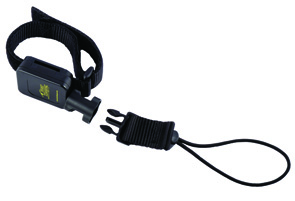Up-Tower Construction, Repair & Maintenance
 Reducing injuries, damage & lost work time with the right tool tethers
Reducing injuries, damage & lost work time with the right tool tethers
Wind turbines require a high degree of maintenance, many times at heights exceeding 300 feet. Although a tool falling from any height is a problem, in the case of wind power maintenance, an object falling several hundred feet endangers everything and everyone below. A large, free-falling tool, such as a torque wrench, could kill someone. Safety is paramount. Even if the tool hits a blade or happens to land on a pump or bearing, it’s going to create significant damage, which would cost a company in lost productivity, workmen’s compensation claims, medical bills, and equipment repairs.
A safety engineer’s goal in correct tethering procedures is to ensure the tool and the application and recoil/retraction force are in balance. When a tool is extended for use, only minimal force should be necessary so as not to cause worker fatigue—or, in reverse, cause a ”kick” when retracted. The result of correct tethering is when a tool is stored, held, or used, the dangers of entanglement, fatigue, and annoyance are minimized while worker satisfaction and output are maximized.
A new safety engineer may ask: How do I know which type of tether to use in each application—retractable tool tether, coiled tool tether, or lanyard tool tether? Should the tether be attached to the worker, or anchored to the structure? Do you need a quick-release system to safely change out tools?
When the correct tether is properly matched with the tool, worker, and application, the work is safer, easier, and more efficient. Conversely, a poorly matched tether can become a safety hazard. The challenge for a safety engineer is to provide a tether that is friendly to the user and appropriate for the work environment.
The common lanyard-type tool tether is not a one-size-fits-all solution.
With such a high risk to worker safety, it’s unfortunate little has been published on the subject of tethering equipment and safety techniques. Most companies that sell safety equipment or personal fall arrest systems fill out their product line by importing a basic tether in two or three sizes. When tool tethers are ordered without specifications beyond the weight of the tool, chances are it may not be appropriate.
In reality, there are thousands of tethering choices for safety engineers available from US manufacturers specializing in tool, gear, and instrument tethers. Tethering systems have been specified by safety engineers for a variety of applications in a broad range of industries. Each application has its own set of criteria: standing up to saltwater, chlorine exposure, and high temperatures, or special mounting or attachment needs.
Use the appropriate lanyards and tethers for each application.
The objective of tethering is to secure tools to prevent injury and damage to people and equipment below. But, there are factors that can impact the safety of the worker using the tether or lanyard. An improperly mated tool and lanyard can lead to reduced productivity and exposure to injury. When the tethering device limits mobility, recoils too quickly, or exerts too much resistance upon extension, backlash from workers is often the result. Backlash can include fatigue, annoyance, or even non-compliance in the use of the lanyard. Dangerous side effects.
For heavier tools, tethers should be anchored to a structure and not a person.
Tethering heavy tools (generally, over five pounds) to a person is a significant safety concern, and safety engineers should instead consider using anchor tethers. Anchored tethering transfers the shock load produced by a dropped tool from the worker to the structure. For heavier tools (over 10 pounds), structure anchoring should be mandatory.
Retractable tethers are recommended for workers using small, hand tools (less than two pounds).
Picture a worker using multiple small tools…the electrician using screw drivers, pliers, amp meters. Or, imagine a maintenance engineer climbing up with a group of tools in his pouch. These tools and working conditions are poor choices for coil type tethers or lanyards. However, they are ideal for a retractable tether that safely permits multiple tools to be attached to the worker with virtually no risk of entanglement or snagging. Tool and gear retractable tethering devices offer hundreds of combinations of mounting systems, line technology, and shock-absorbing capabilities.
Quick-release fittings ideal for multiple tools on one tether.
Change the tool, and not the tether is a slogan worth remembering. A single tool lanyard is sufficient when one specific tool is the only thing tethered, but what if there are multiple tools to tether? This is a common scenario. Here again, there are many options for worker safety in multi-tool tethering situations. Quick-connect tethers offer easy tool change-out and are available on a large selection of tethers.
Tool tether ratings.
Unfortunately, there are no universal specifications governing tool tethers as there are with fall protection devices. As such, a safety engineer has no real basis for choosing proper tethers and arbitrarily determines tether selection based on the weight of the tool (e.g. “I need a tether for a three-pound tool”). Without additional specifications, a safety engineer maybe creating a potentially dangerous situation.
As an example, when a safety engineer requests a tether for a three-pound tool, the distributor might offer to send one that’s rated up to 15 pounds, so there will be a higher safety margin. Although both the supplier and buyer may have good intent in this scenario, it’s a potentially hazardous situation. Using a tether that is rated for a much heavier tool will not operate effectively because the stretch and the recoil are considerably out of scale for the lighter tool.
A more serious problem is when a worker, assuming a lanyard is rated for 15 pounds, thinks he can connect a 15-pound tool to his tool belt. He can’t. That 15-pound tool, at a full drop length, will exceed 250 pounds of a shock load. That’s more than enough to knock a worker off his perch, and more than enough reason to learn and adhere to proper tether selection and safety.
To help industrial safety engineers choose the appropriate “dropped tool” safety device, Hammerhead Industries offers a free “Tool Tether Guide.”
Hammerhead Industries
www.gearkeeper.com
www.gearkeeper.com/tooltethers/Resources/ToolGuide.pdf
Author: John Salentine
Volume: July/August 2011








